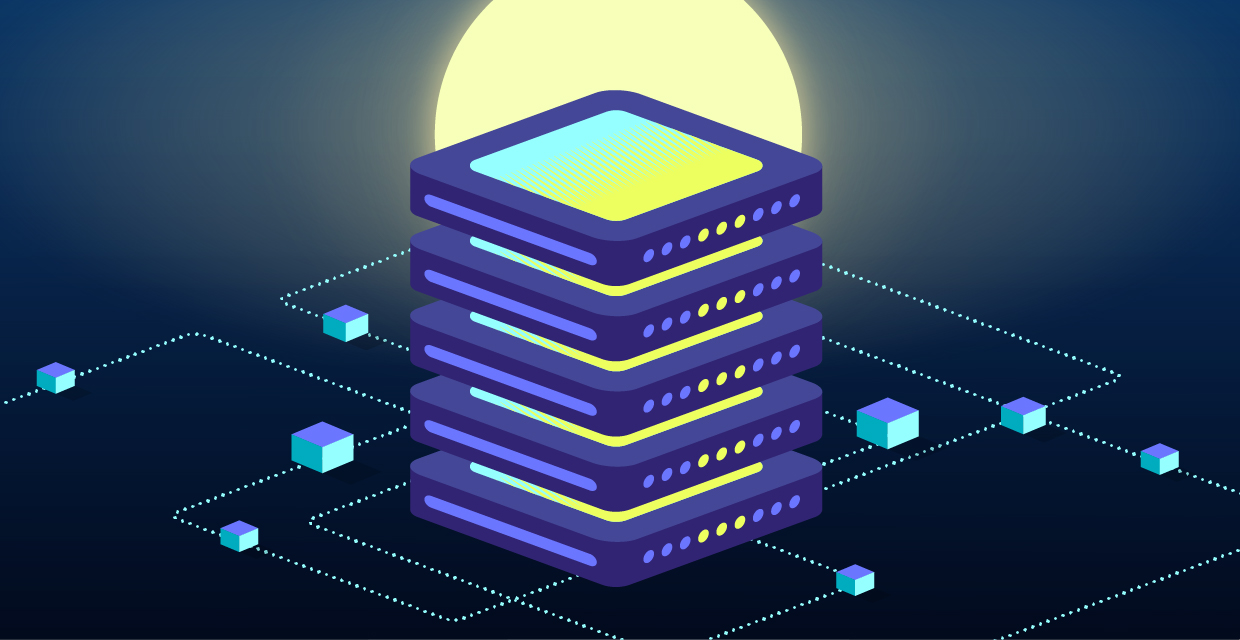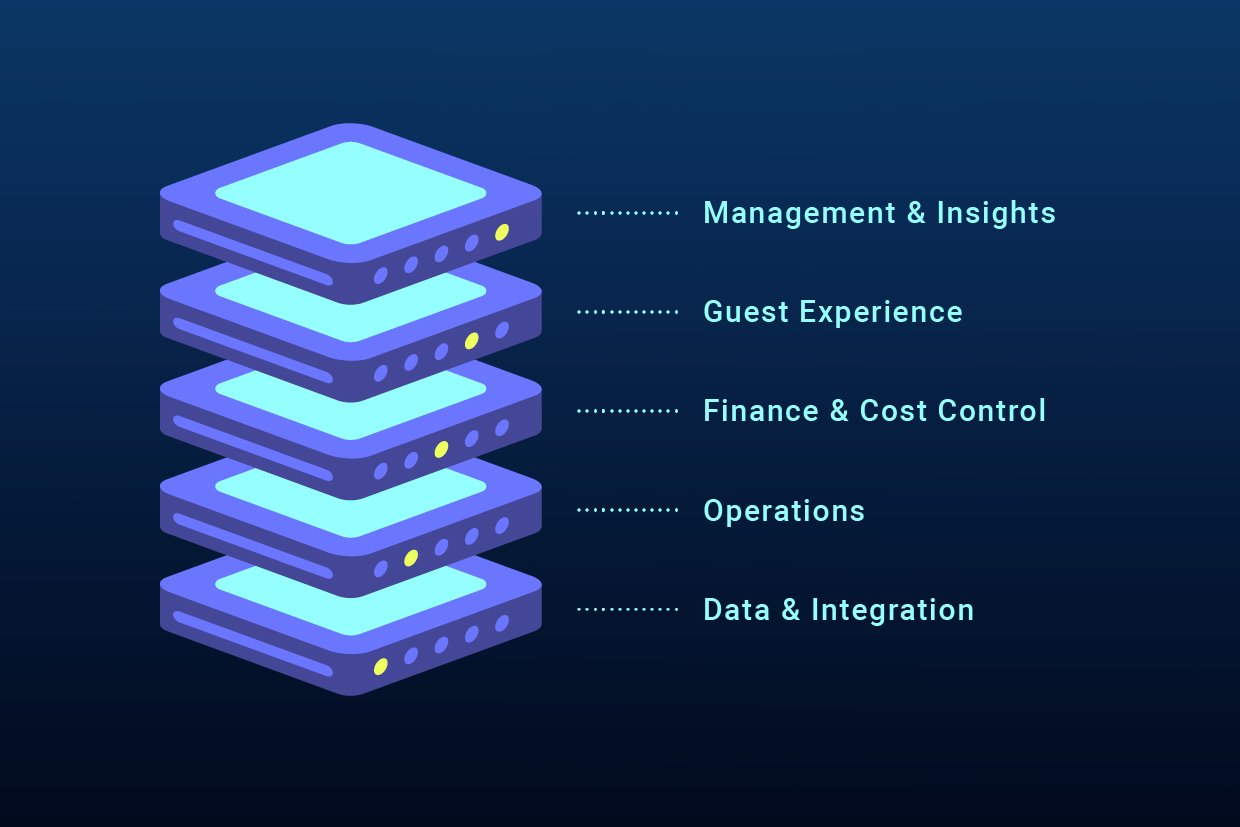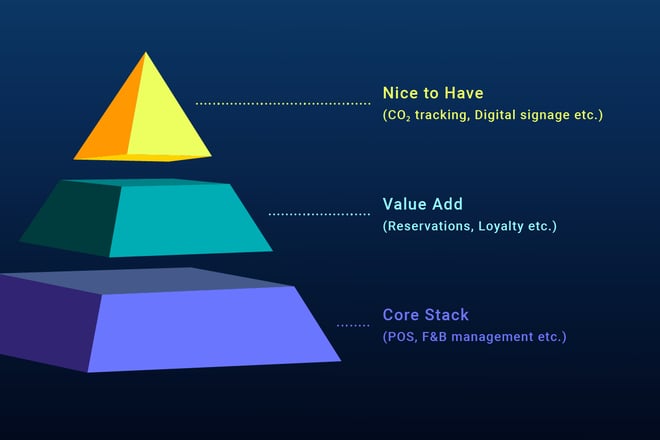7 Financial Mistakes in Hospitality and How to Avoid Them
Avoid these 7 common financial mistakes in the hospitality industry and learn how to run your business successfully.
Discover how future-ready restaurants use connected tech stacks to cut costs, boost margins, and scale smarter.

Guest expectations, margins, and technology are all changing quickly. The market is flooded with tools that promise to solve every problem in food and beverage operations, from procurement and menus to accounting.
So, which of these tools actually matter for your business? How do you assemble a restaurant tech stack that reduces complexity for your teams instead of adding to it?
In this Utopia Gastronomica article, you will learn what a modern restaurant technology stack looks like, how its components are connected, and how to build one that is truly future-proof: scalable across locations, transparent on costs, and designed for real-world operations.
Whether in casual dining, hotels, or catering, today’s restaurateurs face more than just the daily business of guests, menus, and suppliers. They’re managing rising costs, constant data streams, and the pressure to stay profitable while keeping quality high.
This is where a modern restaurant tech stack reveals its true value: it cuts through complexity, provides real-time visibility, and becomes the foundation for profitable, scalable growth.
Before investing in a powerful digital infrastructure, it’s worth asking what a tech stack is and why it’s so critical for the restaurant industry.
A restaurant tech stack is the digital backbone of your business. It encompasses your POS and inventory management, as well as reservations, delivery systems, digital menus and analytics.
The number of tools is irrelevant; what matters is how well they integrate with each other. Only when systems communicate seamlessly you gain the transparency that is needed to manage costs, improve the customer experience and make quick, informed decisions.
Since the pandemic, flexibility has become essential for survival. Restaurants need technology that can grow with them. They need systems that don't require rebuilding with every new challenge.
Recent industry reports highlight this trend: 76% of operators see technology as a competitive advantage, but only 13% are satisfied with their current setup. The result? Investing in a smart, integrated tech stack today improves efficiency and margins and secures a long-term edge in an increasingly competitive market.
The benefits of technology only become apparent when systems are tailored to the specific requirements of your business. Although every restaurant is different and unique, many still rely on rigid, one-size-fits-all 'all-in-one' solutions.
At first glance, these systems seem very appealing: one provider, one interface and one quick setup. In practice, however, they often hinder growth in the hospitality industry. Functions are restricted, integrations are shallow and scaling up across multiple sites becomes difficult.
That’s why forward-thinking operators are embracing best-of-breed architectures. There are specialized tools for each key area that are intelligently connected through APIs. This approach provides depth, flexibility and resilience.
The key difference is that a flexible tech stack does not mean buying everything from one vendor. It means connecting the right systems into a network that fits your workflows and can evolve with your business.
The reality is clear: the modern hospitality landscape doesn’t reward rigid “all-in-ones”. It rewards those who design open, modular ecosystems that are ready to scale.
A modern hospitality tech stack is much more than just a collection of tools. While industries such as retail and e-commerce have been using defined system architectures for years, it is now time for hospitality to catch up.
A tech stack only unlocks its full potential when all its layers interact seamlessly. These five layers provide a clear orientation for building a stable, future-proof digital infrastructure.

Every successful system starts with clean, reliable data. Recipes, ingredients, suppliers, prices and allergens must be centrally managed and consistent across all systems.
What is the biggest risk? Isolated systems and Excel workarounds. When data is stored in silos, connections become fragile and eventually collapse like a house of cards.
The solution lies in an integration layer. APIs connect all systems, ensuring that every application works with the same verified data in real-time.
At FoodNotify, product, recipe and supplier data form the core backbone. Through open APIs, POS systems, accounting software and supplier platforms are automatically synchronized, ensuring that the kitchen, purchasing and finance teams always work from one single source of truth.
These are the core activities of daily business: purchasing, inventory management, menu planning, production and service. Many operators still manage these processes manually in Excel, wasting valuable time and increasing the risk of errors.
A modern tech stack replaces manual processes with automated workflows: orders are suggested automatically, stock levels are updated in real-time and production plans remain consistent across all locations.
With FoodNotify, recipe and menu calculations are based on live prices. If inventory deviations or critical stock levels occur, the system immediately triggers alerts, turning potential losses into quick action and measurable efficiency gains.
This layer translates operational data into real-time financial insights, providing information on everything from COGS and margins to cash flow and variances. Rather than relying on static monthly reports, decision-makers have access to a live cockpit for proactive management.
This enables prices to be adjusted promptly, suppliers to be renegotiated and staffing plans to be optimized. Industry studies show that this level of transparency is key to achieving economic stability in the hospitality industry.
FoodNotify provides visibility into margins and cost structures in real-time. Alerts instantly highlight deviations, and relevant financial data is directly available in the analytics dashboard. This transforms controlling from a retrospective task into an active steering instrument.
Here, the guest’s experience is paramount, particularly in terms of your menu. Prices, allergen information, nutritional values and availability must be accurate and consistent everywhere. A lack of transparency can erode trust and create legal risks.
With FoodNotify, changes to recipes, prices or ingredients only need to be entered once and are updated automatically in your menu. This results in reliable information, a seamless guest experience, and greater trust in your brand.
This layer sits at the top – this is where all data streams converge. Dashboards, reports and AI-driven analytics provide answers to key questions: What is happening? Why is it happening? What should we do next?
Unlike traditional reporting, this layer acts as an early-warning system. Trends, anomalies and opportunities become visible before they affect your bottom line. Research shows that data-driven businesses can improve their operational efficiency by up to 30%.
FoodNotify connects insights across all locations, from revenue and COGS to margins and performance forecasts. With real-time dashboards and predictive analytics, operators can stop reacting and start steering.
Each of these five layers plays a distinct role, but the real value of a tech stack only emerges when they’re interconnected. Clean data fuels operational efficiency. Operations generate insights for finance. Financial transparency supports better guest experiences. Management insights then close the loop with smarter, faster decisions.
When these layers work in harmony, your hospitality business gains a living, learning system that drives performance, profitability and growth. Something far more powerful than digital tools.
A tech stack only delivers real value when its systems communicate with each other, rather than simply coexisting. When data flows seamlessly across all layers, manual effort decreases, automation takes over and decisions become faster and more reliable.
This creates a unified, data-driven ecosystem that minimizes friction, improves control and scales effortlessly across locations, instead of a patchwork of disconnected tools.
To illustrate how this plays out in everyday operations, here are a few examples from the field:
Transparent calculations
A manager overseeing twelve locations used to rely on multiple price lists and Excel spreadsheets. Now, with centralized data, price updates automatically flow into recipe costing and margin alerts appear on the dashboard. The result is a 5% increase in gross margin within three months.
Reduced waste
One restaurant reduced its food costs by 8% after introducing automated purchasing suggestions, simply by preventing overordering and spoilage.
Scalable growth
A franchise group with 20 locations can now onboard new locations within a few days. Recipes, supplier data and purchase workflows are standardized from day one, making growth predictable rather than chaotic.
These examples demonstrate one key point: a well-integrated tech stack not only digitizes processes, but also transforms them into a self-optimizing system that increases efficiency, reduces costs and enables sustainable growth.
As digital systems become more complex, clarity and structure are essential. A clear architectural model helps everyone, from management to investors, to understand how each component fits into the bigger picture, and how technology drives performance across the organization.
The five-layer model offers exactly this perspective. It illustrates the connections between data, operations, finance, guest interaction and management insights, showing how they come together to build one coherent system.
At a glance, it is clear:
This clarity is a game-changer for decision-makers and stakeholders alike. Rather than being perceived as a colorful mix of disconnected tools, the tech stack becomes a strategic roadmap for sustainable, scalable growth.
Once you understand how a tech stack works in daily hospitality operations, the next question you might have: How do you build one that will remain relevant for years to come?
The answer does not lie in short-term tools or trends, but rather in clear system architecture and the right priorities.
Centralized data
Every system must rely on the same master data. When products, prices and recipes are consistent across all tools, duplicates disappear, pricing errors vanish, and costly manual corrections become unnecessary. A single source of truth is the foundation for reliable automation and accurate analysis.
Automation of routine tasks
From automated price updates and recipe costing to order suggestions, automation saves time and reduces errors, allowing your team to focus on what truly matters: your guests and the quality of your dishes.
Real-time insights and financial integration
A modern tech stack provides real-time access to key financial metrics such as COGS, margins and cash flow, rather than weeks later. This enables proactive decision-making, allowing managers to react before costs spiral out of control.
API and logical integrations
Your tech stack should function like a living organism. Whether it's the POS, purchasing, inventory or accounting systems, they must communicate in sync. Clean integration logic prevents system chaos and ensures long-term scalability.
Scalability and usability
A business with three locations requires different tools than a chain with thirty. This is exactly why systems must be scalable, growing alongside your operations, while remaining intuitive to use. Only tools that staff can understand and enjoy using will deliver long-term value.
Support and training
Even the best software is useless if the team doesn’t know how to use it. Choose a provider that offers hands-on training, onboarding and ongoing support to ensure data is collected and used effectively for decision-making.
Economic sustainability
A tech stack isn’t just a cost centre; it’s an investment in efficiency and future growth. Before implementation, assess license costs, setup efforts and scalability to ensure your digital foundation pays off in the long term.
Which systems are truly mission-critical?
Not all tools contribute equally to your success. Some systems form the digital backbone, while others enhance or complement them. The key here is to identify the “mission-critical” systems for your business.
|
Category |
Tools |
Why they matter |
|
Core Stack |
POS, F&B management, inventory |
Foundation for operations and data flow |
|
Value Add |
Reservations, loyalty, guest feedback |
Optimize processes and enhance guest satisfaction |
|
Nice to Have |
CO₂ tracking, AI menu planning, digital signage |
Provide additional value, but only once the core is stable |
A simple rule of thumb: Build your core stack first. Without a strong foundation, add-ons can become distracting, turning relief into overload.

Once your digital systems are in place, there is only one crucial question that remains: Is the investment paying off?
Modern restaurant operators are increasingly recognizing that the ROI of a tech stack goes far beyond cost savings. It's about achieving tangible improvements in efficiency, productivity and guest experience. The key performance indicators that directly impact profitability.
How to measure the impact of your tech stack:
ROI = (Benefits – Costs) / Costs
Benefits: Time savings, reduced food waste, increased margins through precise costing and higher average spend per customer.
Costs: Licenses, implementation, training and change management.
Establish baseline values for your key KPIs before you start and review them every three to six months to see how the new systems are performing. Baseline values simply represent your starting point: the numbers that reflect your operation before digital improvements are made.
COGS and margin at a glance: Operational data, such as consumption, pricing and performance, is updated automatically in dashboards, giving management a real-time view of profitability.
Alerts instead of gut feeling: Automatic notifications for cost or usage deviations help restaurateurs to act quickly, for example by reviewing prices, adjusting recipes or negotiating with suppliers.
Accurate data for reliable calculations: Changes to articles, prices, or allergens automatically flow into menus and recipes, ensuring consistent calculations and realistic upselling opportunities.
Faster stocktaking and purchasing: Digital stock levels, automated order suggestions and structured goods receipt reduce the time spent on administrative tasks, creating direct savings in both COGS and labor hours.

In most digital transformation projects, the biggest challenge is not the technology, but the people. Even the most advanced system only delivers results when everyone understands its value and uses it consistently in their daily routines. Successful implementation depends on three key factors.
Define clear responsibilities at all levels
Define the roles and responsibilities of each department, including operations, finance, IT, customer experience and insights. Who is responsible for which decisions? Who ensures data quality and manages process adjustments? Without clear accountability, even the best systems can cause confusion rather than clarity.
Executive support and communication
Digital transformation must be led from the top. When leadership clearly communicates the purpose and long-term value of the project, it gains momentum and acceptance across the organization. Managers need to explain the 'why', not just the 'how', to keep teams motivated and aligned.
Early stakeholder involvement
Include key stakeholders, such as kitchen staff, service teams, the finance department, the IT department, investors or franchise partners, early in the process. Workshops, pilot phases and open communication help to build trust and enable employees to experience the benefits first-hand. People who understand how technology can improve their work are far more likely to embrace it.
Change management is not an optional step. It is the core success factor of any digital initiative. Only when everyone recognizes the value of the system will it become part of everyday operations rather than just another unused tool.
Not long ago, decisions about new digital tools were often made by kitchen managers or operations leads. Today, however, CIOs, CTOs and Heads of Digital play a central role in building a scalable, future-ready tech stack.
This change is no coincidence: your tech stack has become the digital infrastructure of your business. It is as important for the future as location, brand development or financial planning.
For restaurant leaders, this means:
The tech stack has become as critical to business strategy as brand development or location choice. Leadership that actively drives digital transformation turns technology into a lasting competitive advantage.
A modern tech stack improves efficiency and supports sustainability and responsibility, both of which are becoming key priorities for guests, investors and franchise partners. Digital systems enable environmental and social impact to be measured, monitored, and managed as precisely as financial performance.
Here’s how technology can contribute to more sustainable restaurant operations:
Integrating sustainability into data-driven processes, FoodNotify makes the tech stack a driver of transparency, innovation and long-term value creation. This improves operational efficiency and strengthens your brand’s credibility and environmental impact.
The next digital leap in the restaurant industry will be driven by artificial intelligence (AI) and predictive analytics. These technologies transform reactive management into proactive decision-making, helping businesses to anticipate challenges before they arise and to identify new opportunities for efficiency, sustainability and guest satisfaction.
Here are some of the most promising use cases for the coming years:
At FoodNotify, we’re actively integrating AI-driven features like these into our platform – not as futuristic add-ons, but as practical tools that make everyday operations smarter and more sustainable. Our goal is to empower hospitality businesses to work more efficiently today while gaining a clear competitive advantage for the future.
The future of hospitality lies in integration: systems, data and people working together seamlessly. A connected, data-driven infrastructure can transform daily operations into a single, efficient process, covering everything from purchasing and production to financial control and management insights.
Restaurants that develop a strategic tech stack today are investing not just in software, but also in efficiency, sustainability and long-term competitiveness.
At FoodNotify, we see ourselves as a strategic partner for digital transformation, not just a software provider. Thanks to our open API architecture, in-depth industry expertise and focus on usability and sustainability, we help hospitality businesses to connect their data, scale their operations and stay ahead of the curve.
Want to know how future-ready your tech stack really is? Let’s find out together. In a free initial consultation, we’ll show you where your biggest digital opportunities lie – from inventory and recipe management to procurement and analytics.
Avoid these 7 common financial mistakes in the hospitality industry and learn how to run your business successfully.
The Supply Chain Act poses significant challenges for many businesses. Find out how ERP systems can streamline compliance and reduce hospitality...
Want to know how to reduce food waste in restaurants? Here are 5 tips you can use to avoid wasting food in your hospitality business.
Make sure you never miss out on updates and trends about digitalization in the hospitality industry by subscribing to our monthly newsletter. You will receive useful information delivered directly to your inbox.